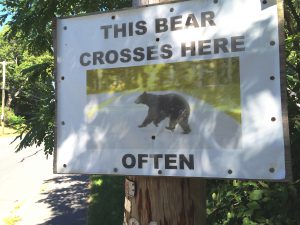This Bear Crosses Here, Often
« Previous Post Next Post »“This bear crosses here, often,” is a sign that stands along the side of Route 66 in Northampton, MA. It is a homemade sign that marks the spot that a local black bear crosses this state road.  Alongside highways in Colorado and Arizona, highway departments have installed engineered wildlife escape measures, including earthen ramps. These ramps provide deer and elk, as well as other large mammals, escape routes from the fenced highway area. These installation are a function both of highway safety concerns and wildlife corridor needs. And these kinds of measures are not just limited to mammals. Amherst, Massachusetts, and communities around the world, are installing tunnels, culverts and drift fencing to guide salamander migration under and away from roadways.
Alongside highways in Colorado and Arizona, highway departments have installed engineered wildlife escape measures, including earthen ramps. These ramps provide deer and elk, as well as other large mammals, escape routes from the fenced highway area. These installation are a function both of highway safety concerns and wildlife corridor needs. And these kinds of measures are not just limited to mammals. Amherst, Massachusetts, and communities around the world, are installing tunnels, culverts and drift fencing to guide salamander migration under and away from roadways.
The People’s Way, “the most progressive and extensive wildlife-oriented road design program in the country,” according to Orion Magazine article, Right of Way – Reimagining Infrastructure, was designed and built by a partnership of the Confederated Salish and Kootenai Tribes, the Montana Highway Department and Montana State University. According to The People’s Way website , this 56 mile section of Highway North 93 contains “41 fish and wildlife crossing structures, 18 miles of fencing, 60 jump-outs and numerous wildlife crossing guards.” Motion cameras – and go check out the Youtube video here – provide evidence of extensive usage. Cameras have documented “53,600 uses between 2010 and 2012, by over 30 species” ranging from mountain lions to mallards, from bears to bobcats, from wild turkeys to domestic cows!
According to the American Bird Conservancy (ABC), more than one billion birds die as a result of flying into glass windows. The ABC has worked with LEED (Leadership in Energy and Environmental Design, the green building certification program) to develop pilot bird-friendly architecture guidelines, they are engaged in research and development to create bird friendly glass, and advocate for legislation that will protect birds by requiring bird-friendly materials.
Road construction often requires the installation of culverts to channel brooks, streams and larger tributaries. Culvert construction can be fish-friendly, or devastating to their migration, spawning and habitat. The placement, design and timing of the construction are critical factors. Done right, the impact on fish and other aquatic life, including mink and otter, frogs, snails and crayfish, is minimized, while allowing for appropriate roadways. For a geeky, but wholly accessible, perspective on this, check out the Wisconsin Extensive Services publication, Fish Friendly Culverts .
Engineers, wildlife biologists, highway crews, architects, policy makers, and neighbors have designed, installed and advocated for these measures. Each is an example of our recognition that we share this planet with avian, mammalian, amphibian, reptilian and fish residents. Implicit in these examples is, to varying degrees, the sense that our decisions about how we live can be in direct conflict with how other creatures live. But, those decisions don’t have to be. In what ways do you share space with other creatures? Are there ways that your work supports others to live as they need to?
This week, as with other weeks, some thinking on what our eco system role as residents on a planet facing climate changes can look like. More thinking can be found at Finding Earth Works.
You can comment on any of these perspectives, and it would be welcomed. Particularly, tell us all about your eco system role.



Wonderful…. I love the various resources you have drawn from and the stats. It is full of great information and especially for guys like me who take note of the wildlife ramps along I-70, but don’t take the time to think how important such measures are for all critters! It is a great example of how Earth should Work!!
great, thanks for doing this and spreading knowledge!
best, Marcel
Western Transportation Institute – Montana State University